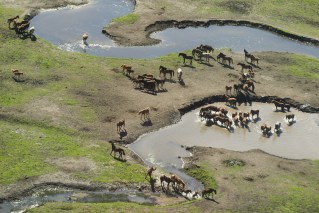It is unlikely that Australia will get any respite from extreme weather over summer following a sustained period of heavy rain and flooding, with experts predicting the nation’s bushfire risk will soon increase.
The Australasian Fire and Emergency Service Authorities Council (AFAC) released its seasonal bushfire outlook for the 2022 summer on Tuesday, which predicted an above-normal fire risk for central western and southern Western Australia, Central Australia, southern Queensland and inland NSW.
The higher risk is due to flourishing vegetation after recent rains, which mean increased fuel loads.
In some good news, wetter areas across Victoria, New South Wales and the ACT are expected to have below-normal fire risk at the start of summer, thanks to recent heavy rainfall or flooding and reduced vegetation following the 2019-20 bushfire season.
While soils will remain saturated as summer begins, Victoria’s Emergency Management Commissioner Andrew Crisp says the risk of grass fires could increase later in summer as it dries out, especially given the significant growth already evident across the state.
Those fears are shared by the state’s Country Fire Authority Chief Officer Jason Heffernan, who stated that Victoria is one of the world’s most fire-prone areas.
“Even an average fire season can have devastating consequences,” Mr Heffernan said on Tuesday.
Tasmanian Fire Service Chief Officer Dermot Barry said while most of his state could expect normal fire potential, parts of the southwest have been drier than the rest of the state for some time.
“The flammability of peat soils, moorlands, scrubs, and heaths are predicted to be greater than normal in these areas,” he said on Tuesday.
“Lightning strikes in these areas may ignite fires which could be difficult to control.”
Tasmanians should be wary of fast-moving grass fires when fire-prone grass dries out in January, Mr Barry said.
AFAC chief executive Rob Webb said while most of Australia shows normal fire potential during the summer period, destructive and deadly fires can still occur during normal bushfire seasons.
“This outlook shows a diversity of fire risk this season, which reflects the diversity of Australia’s landscape,” he said.
“As we enter summer, we will use this outlook to guide our operational and strategic planning, and jurisdictional fire and emergency services will continue to monitor local conditions.”
The seasonal outlook was developed in consultation with fire agencies and emergency services across Australia.
Climate change fuels more fires
If it seems like bushfires are becoming more frequent and severe – that’s because they are.
AFAC placed the blame on global warming, with Australia’s climate having warmed by 1.47 degrees between 1910 and 2020.
This warming has led to increasingly frequent extreme heat events and high intensity rainfall, particularly across northern Australia.
Above-average winter and spring rainfall means more grass and vegetation growth, which leads to a higher grassfire risk during warm, windy and dry summer periods.









